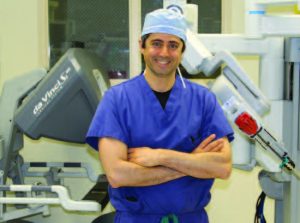Westfield native leaves California in quest of advanced surgery at Trinitas.
When Sena O’Connor-McLellan embarks on her regular daily run along the trails of the Diablo Mountains of California’s Bay Area, she is doing something her West Coast doctors said would never happen: regaining the physically active lifestyle she enjoyed before uterine prolapse began slowing her down. A native of Westfield and an avid runner, O’Connor-McLellan initially consulted with her California physicians, who recommended a radical solution.
“They said I’d have to have my cervix removed and give up running,” she recalls. “That didn’t feel right to me. That’s when I called Dr. Riachi.”
Dr. Labib Riachi, Chairman, OB/GYN, and Director of Robotics at Trinitas Regional Medical Center, had treated O’Connor-McLellan for a separate condition in 2009, using a robotics-assisted procedure that she says resulted in a smoother-than-anticipated recuperation. The surgical scars were practically unnoticeable, and the discomfort was minimal. After a phone call to Dr. Riachi, she boarded a plane back to New Jersey, consulted with him at his office, and was scheduled for surgery the next day. Once again, the robotics-assisted procedure delivered results.
“Four small incisions—that’s all it took,” says O’Connor-McLellan, a mother of four sons ages 15 to 20. “So unobtrusive, so simple. It wasn’t painful to roll over and I could pull myself up to get out of bed. Within a week, I was on a plane back to California. By two weeks, I was completely back to being myself.”
The procedure, which is performed using the daVinci Surgical System, is called a robotic cervicosacropexy. It involves the insertion of an abdominal mesh to relieve the prolapse and in most cases is a permanent solution with few if any lingering effects. After six weeks, as Dr. Riachi promised, O’Connor-McLellan was able to restart her trail work with a slow jog. “It is very rewarding to see people such as Sena benefit from this minimally invasive technology,” he says. “The daVinci system enables us to perform delicate surgeries in a faster and more secure way. It allows us to be more aggressive in how we treat, while giving us almost unlimited access within the surgical field.”

Labib Riachi, MD
Chairman, OB/GYN, and Director of Robotics
at Trinitas Regional Medical Center
908.282.2000
The daVinci system allows a surgeon working at a console to manipulate four robotic “arms” that maneuver a camera and carry out cutting, holding and coagulating all through a single or multi-port precise abdominal incision. Dr. Riachi has used the system to perform corrective surgeries for conditions such as prolapse, bleeding, fibroids, uterine cancer, and endometriosis. He now trains other surgeons to do the same. In all, he has carried out more than 800 robotic procedures since 2009.
“I call him the rock star,” O’Connor-McLellan says. “I would still go back to New Jersey if I needed another procedure, and I recommend anyone else to make that trip as well. I wouldn’t trust anyone else; I wouldn’t put my health in anyone else’s hands. I feel that strongly about what he can do, and about robotics in surgery. People shouldn’t be afraid of it. The healing is incredible.”
 NO COMPARISON
NO COMPARISON
In 2007, Sena O’Connor-McLellan (below and on page 46) underwent a non-robotic laparoscopic procedure to treat Crohn’s Disease. “The recuperation was longer, more painful, and generally much worse,” she reports, adding that she hopes that her experience will lead other women to explore the benefits of robotics-assisted surgery. “Women put off things like [prolapse correction] because they think they can’t get it done and get back to life. You think the only option is surgery that will put you on your back for two weeks. But the robotics option gets you back on your way in a few days. The flu will put you down for longer!”
Editor’s Note: Sena O’Connor-McLellan is back to enjoying the lifestyle she loves, hitting the trails every day for a running routine which, less than a year ago, she was advised to give up. Every mile she covers is a testament to the difference Dr. Riachi and the daVinci system can make. Next up for O’Connor-McLellan is the Rock & Roll Half-Marathon for the Crohn’s and Colitis Foundation of America in November on the Las





